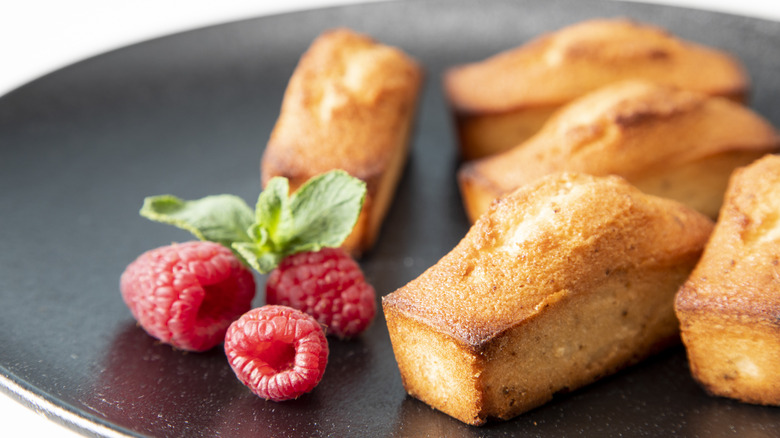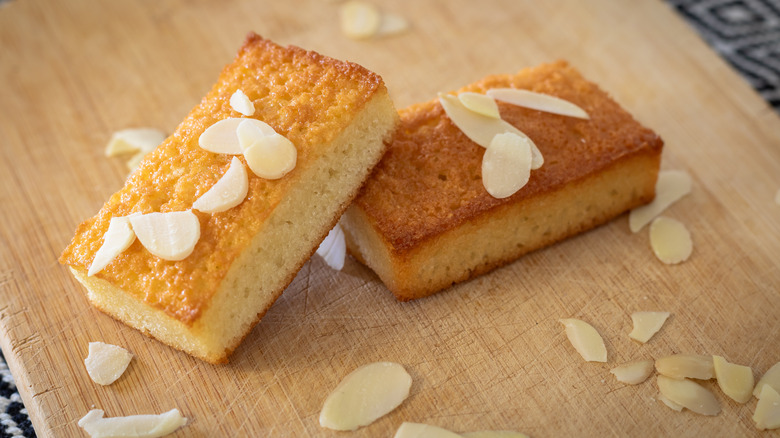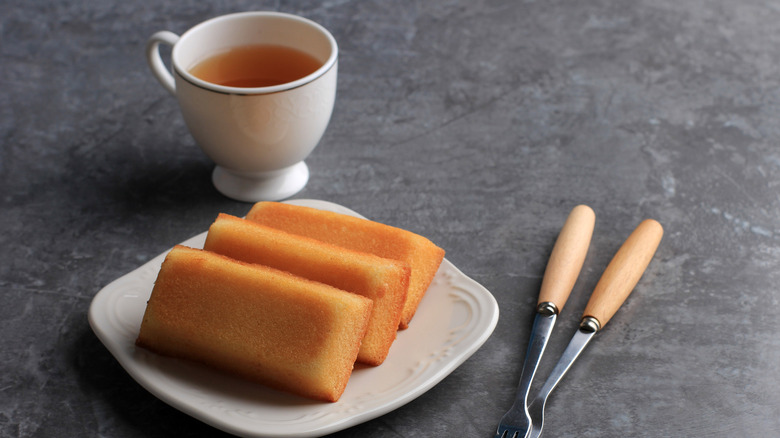Where Does Financier Cake Get Its Name?
French patisseries are known for their gorgeous array of pastries and confectioneries, each delicately made and displayed like they're works of art (because they are!). Glass cases lined with colorful macarons and fluffy croissants would make anyone's mouth water, but one of the simplest, most delicious pastries you may find in a French patisserie is a financier cake — a simple almond flavored cake with a crisp outside and soft inside, which takes its name from the world of finance.
Financier cakes were first offered at a patisserie near the Paris stock exchange in the late 1800s. Cookbook author and baking expert Dorie Greenspan shares on her website that the pastry chef responsible for creating this cake was a man named Lasne. He wanted to create a pastry that would attract nearby bankers, so he decided to bake cakes to resemble ingots or bars of gold. Not only that, but because these bank employees were busy, he kept his bakes bite-sized and easy to eat without any utensils. Lasne aptly named them financier cakes. The name and the shape of the pastries were undoubtedly a draw for the bankers, but it was, of course, the taste of these cakes that made them a success.
When were financier cakes first made and what are they exactly?
Financier cakes are very similar to traditional madeleines as they're both almond flavored, and they share the same golden brown color. Financiers utilize brown butter to keep the cake extra rich and moist, while egg whites keep the cake fluffy. And since these are almond cakes, almond flour is used to give them their signature nutty flavor. Very much a delicacy, these simple cakes are best eaten on the day they're baked, as they lose their texture fairly quickly.
When baking financier cakes at home, there are a few tips and tricks to keep in mind. According to Amanda Hesser of The New York Times, browning the butter is especially important since this enhances the nuttiness and richness of the cake. Browning butter can be tricky since it can burn rather quickly, so be sure to brown butter over a gentler heat setting and remove it as soon as it turns golden brown. Hesser also recommends being mindful of the batter, avoiding over-stirring, and giving it ample time to sit and settle before baking. This way, the flavors have time to meld together while the batter firms up, making piping a breeze.
Where to find financier cakes today
Luckily for us all, financier cakes made their way beyond the Paris stock exchange and can now be found in both French patisseries and restaurants around the world. Instead of resembling gold bars, you can now find them in a variety of shapes, and they come in different flavors as well. Colson Patisserie in Brooklyn, New York, offers financiers as mini muffins and are sold plain, raspberry, pistachio, or chocolate flavored, while Ladurée Paris features a small, round dulce de leche financier filled with hazelnut cream. Lou, The French On The Block is a patisserie in Los Angeles that is wildly popular, thanks to pastry chef and owner Laurent "Lou" Correa's delicious pastries. His bakery is only open on the weekends, and you'll find almond and raspberry financiers there while they last.
You could certainly try your hand at making financiers at home as well. Start out with a pared-down recipe or go bold with a pistachio and almond financier, or if you like a bit more sweetness, add honey to the recipe for a honey financier.
Whether you prefer the simple elegance of a plain financier, or you like your cake topped with raspberry or chocolate— you can nibble on your French pastry with the confidence in knowing why they're called financier cakes in the first place. No banking job required!


